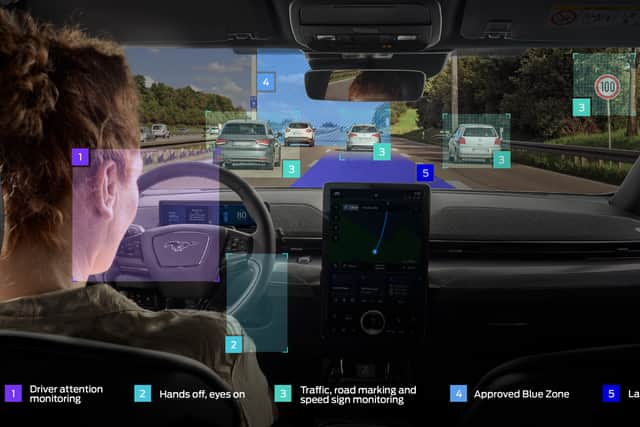Ford BlueCruise: how it works as Britain’s first legal ‘hands-off’ driving system - motorway use explained
and live on Freeview channel 276
Ford has become the first car maker to obtain government approval for “hands-off” driver assistance systems in the UK.
The US firm has received regulatory approval for its BlueCruise technology on the Mustang Mach-e, meaning drivers can legally take their hands away from the steering wheel while the car controls the steering and speed on certain pre-mapped sections of road.
Advertisement
Hide AdAdvertisement
Hide AdPresented as level 2-plus autonomy, Ford says the system is a hands-off, eyes-on technology, meaning that the driver must still be paying attention to the situation around them and be ready to take back full control of the vehicle.
The system has been approved for use on 2,300 miles of motorway in England, Scotland and Wales, designated as “Blue Zones” by Ford. It uses a combination of radars and cameras to monitor road markings and signs, and to detect and track the position and speed of other vehicles on the road. The car’s adaptive cruise control and lane keep assistance systems then use this information to position the car correctly and maintain a safe distance from other vehicles as well as adapting speeds to local limits.
Such technology is already available but the BlueCruise approval marks the first time drivers will legally be allowed to take their hands away from the steering wheel and leave the system to fully control the car’s speed and positioning. The system works up to 80mph and, like the existing adaptive cruise control, works right down to a complete stop. Ford says the system will even work when faced with worn-out lane markings, poor weather and roadworks.
To ensure the driver is still paying attention to the road, the system uses an infrared driver-facing camera located below the instrument cluster to check the driver’s eye and head position. If it detects the driver is not paying attention, it uses a series of visual and audio warnings before slowing the car while maintaining steering control.


Advertisement
Hide AdAdvertisement
Hide AdMartin Sander, general manager of Ford Model e, Europe, said: “It’s not every day that you can say you’ve placed one foot in the future, but Ford BlueCruise becoming the first hands-free driving system of its kind to receive approval for use in a European country is a significant step forward for our industry.
“Modern highways can be demanding even for the most confident drivers, and intimidating for many. BlueCruise can do some of the ‘heavy lifting’, to make highway driving less of a chore, and give drivers that little extra confidence and convenience.”
The technology’s introduction to the UK follows more than 700,000 miles of testing and it is is already in use in in more than 193,000 Ford and Lincoln vehicles in the US and Canada. Unlike models in North America, Blue Cruise in the UK still requires driver input to change lanes.
The system is being offered as a £17.99 per month subscription feature on new versions of the Mustang Mach-E EV but Ford says it hopes to offer an over-the-air upgrade to existing Mach-E models and will eventually fit it to other models.
Advertisement
Hide AdAdvertisement
Hide AdThe government wants the UK to be at the forefront of the development of autonomous vehicles and approval for advanced lane keep assist systems (ALKS) like BlueCruise is seen as the first step on this journey.
“It is great news that Ford has chosen us for the European launch of its BlueCruise technology, and I am delighted that this country is once more at the forefront of innovation,” said Jesse Norman, UK Transport Minister. “The latest advanced driver assistance systems make driving smoother and easier, but they can also help make roads safer by reducing scope for driver error.”
Comment Guidelines
National World encourages reader discussion on our stories. User feedback, insights and back-and-forth exchanges add a rich layer of context to reporting. Please review our Community Guidelines before commenting.
